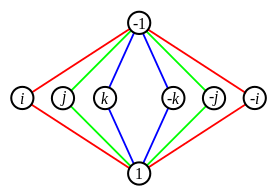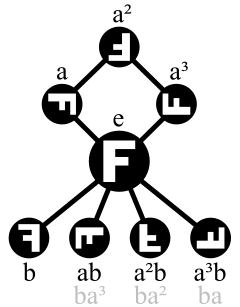Quaternion group
In group theory, the quaternion group Q8 (sometimes just denoted by Q) is a non-abelian group of order eight, isomorphic to a certain eight-element subset of the quaternions under multiplication. It is given by the group presentation
| Algebraic structure → Group theory Group theory |
|---|
 |
|
|
Infinite dimensional Lie group
|

where e is the identity element and e commutes with the other elements of the group.
Compared to dihedral group
The quaternion group Q8 has the same order as the dihedral group D4, but a different structure, as shown by their Cayley and cycle graphs:
| Q8 | D4 | |
|---|---|---|
| Cayley graph |  Red arrows represent multiplication by i, green arrows by j. |
 |
| Cycle graph |  |
 |
The dihedral group D4 can be realized as a subset of the split-quaternions in the same way that Q8 can be viewed as a subset of the quaternions.
Cayley table
The Cayley table (multiplication table) for Q8 is given by:[1]
| × | e | e | i | i | j | j | k | k |
|---|---|---|---|---|---|---|---|---|
| e | e | e | i | i | j | j | k | k |
| e | e | e | i | i | j | j | k | k |
| i | i | i | e | e | k | k | j | j |
| i | i | i | e | e | k | k | j | j |
| j | j | j | k | k | e | e | i | i |
| j | j | j | k | k | e | e | i | i |
| k | k | k | j | j | i | i | e | e |
| k | k | k | j | j | i | i | e | e |
Properties
The quaternion group has the unusual property of being Hamiltonian: every subgroup of Q8 is a normal subgroup, but the group is non-abelian.[2] Every Hamiltonian group contains a copy of Q8.[3]
The quaternion group Q8 is one of the two smallest examples of a nilpotent non-abelian group, the other being the dihedral group D4 of order 8.
The quaternion group Q8 has five irreducible representations, and their dimensions are 1,1,1,1,2. The proof for this property is not difficult, since the number of irreducible characters of Q8 is equal to the number of its conjugacy classes, which is five ( { e }, { e }, { i, i }, { j, j }, { k, k } ).
These five representations are as follows:
Trivial representation
Sign representations with i,j,k-kernel: Q8 has three maximal normal subgroups: the cyclic subgroups generated by i, j, and k respectively. For each maximal normal subgroup, we obtain a one-dimensional representation with that subgroup as kernel. The representation sends elements inside the subgroup to 1, and elements outside the subgroup to -1.
2-dimensional representation: A representation : is given below in the Matrix representations section.
So the character table of the quaternion group Q8, which turns out to be the same as the character table of the dihedral group D4, is:
| Representation/Conjugacy class | { e } | { e } | { i, i } | { j, j } | { k, k } |
|---|---|---|---|---|---|
| Trivial representation | 1 | 1 | 1 | 1 | 1 |
| Sign representations with i-kernel | 1 | 1 | 1 | -1 | -1 |
| Sign representations with j-kernel | 1 | 1 | -1 | 1 | -1 |
| Sign representations with k-kernel | 1 | 1 | -1 | -1 | 1 |
| 2-dimensional representation | 2 | -2 | 0 | 0 | 0 |
In abstract algebra, one can construct a real four-dimensional vector space as the quotient of the group ring R[Q] by the ideal defined by spanR({e+e, i+i, j+j, k+k}). The result is a skew field called the quaternions. Note that this is not quite the same as the group algebra on Q8 (which would be eight-dimensional). Conversely, one can start with the quaternions and define the quaternion group as the multiplicative subgroup consisting of the eight elements {1, −1, i, −i, j, −j, k, −k}. The complex four-dimensional vector space on the same basis is called the algebra of biquaternions.
Note that i, j, and k all have order four in Q8 and any two of them generate the entire group. Another presentation of Q8[4] demonstrating this is:
One may take, for instance, i = x, j = y and k = xy.
The center and the commutator subgroup of Q8 is the subgroup {e,e}. The factor group Q8/{e,e} is isomorphic to the Klein four-group V. The inner automorphism group of Q8 is isomorphic to Q8 modulo its center, and is therefore also isomorphic to the Klein four-group. The full automorphism group of Q8 is isomorphic to the symmetric group of degree 4, S4, the symmetric group on four letters. The outer automorphism group of Q8 is then S4/V which is isomorphic to S3.
Matrix representations
The quaternion group can be represented as a subgroup of the general linear group GL2(C). A representation
is given by
Since all of the above matrices have unit determinant, this is a representation of Q8 in the special linear group SL2(C). The standard identities for quaternion multiplication can be verified using the usual laws of matrix multiplication in GL2(C).[5]
.svg.png)
There is also an important action of Q8 on the eight nonzero elements of the 2-dimensional vector space over the finite field F3. A representation
is given by
where {−1, 0, 1} are the three elements of F3. Since all of the above matrices have unit determinant over F3, this is a representation of Q8 in the special linear group SL(2, 3). Indeed, the group SL(2, 3) has order 24, and Q8 is a normal subgroup of SL(2, 3) of index 3.
Galois group
As Richard Dean showed in 1981, the quaternion group can be presented as the Galois group Gal(T/Q) where Q is the field of rational numbers and T is the splitting field, over Q, of the polynomial
- .
The development uses the fundamental theorem of Galois theory in specifying four intermediate fields between Q and T and their Galois groups, as well as two theorems on cyclic extension of degree four over a field.[6]
Generalized quaternion group
A generalized quaternion group is sometimes defined to be a dicyclic group of order a power of 2,[7] which admits the presentation
and sometimes defined simply the same as a dicyclic group,[4] with presentation
for some integer n ≥ 2. This group is denoted Q4n and has order 4n.[8] Coxeter labels these dicyclic groups ⟨2, 2, n⟩, being a special case of the binary polyhedral group ⟨ℓ, m, n⟩ and related to the polyhedral groups (p,q,r), and dihedral group (2,2,n). The usual quaternion group corresponds to the case n = 2. The generalized quaternion group can be realized as the subgroup of GL2(C) generated by
where ωn = eiπ/n.[4] It can also be realized as the subgroup of unit quaternions generated by[9] x = eiπ/n and y = j.
The generalized quaternion groups have the property that every abelian subgroup is cyclic.[10] It can be shown that a finite p-group with this property (every abelian subgroup is cyclic) is either cyclic or a generalized quaternion group as defined above.[11] Another characterization is that a finite p-group in which there is a unique subgroup of order p is either cyclic or a 2-group isomorphic to generalized quaternion group.[12] In particular, for a finite field F with odd characteristic, the 2-Sylow subgroup of SL2(F) is non-abelian and has only one subgroup of order 2, so this 2-Sylow subgroup must be a generalized quaternion group, (Gorenstein 1980, p. 42). Letting pr be the size of F, where p is prime, the size of the 2-Sylow subgroup of SL2(F) is 2n, where n = ord2(p2 − 1) + ord2(r).
The Brauer–Suzuki theorem shows that groups whose Sylow 2-subgroups are generalized quaternion cannot be simple.
See also
- binary tetrahedral group
- Clifford algebra
- dicyclic group
- Hurwitz integral quaternion
- List of small groups
- 16-cell
Notes
- See also a table from Wolfram Alpha
- See Hall (1999), p. 190
- See Kurosh (1979), p. 67
- Johnson 1980, pp. 44–45
- Artin 1991
- Dean, Richard (1981). "A Rational Polynomial whose Group is the Quaternions". The American Mathematical Monthly. 88 (1): 42–45. JSTOR 2320711.
- Roman, Steven (2011). Fundamentals of Group Theory: An Advanced Approach. Springer. pp. 347–348. ISBN 9780817683016.
- Some authors (e.g., Rotman 1995, pp. 87, 351) refer to this group as the dicyclic group, reserving the name generalized quaternion group to the case where n is a power of 2.
- Brown 1982, p. 98
- Brown 1982, p. 101, exercise 1
- Cartan & Eilenberg 1999, Theorem 11.6, p. 262
- Brown 1982, Theorem 4.3, p. 99
References
- Artin, Michael (1991), Algebra, Prentice Hall, ISBN 978-0-13-004763-2
- Brown, Kenneth S. (1982), Cohomology of groups (3 ed.), Springer-Verlag, ISBN 978-0-387-90688-1
- Cartan, Henri; Eilenberg, Samuel (1999), Homological Algebra, Princeton University Press, ISBN 978-0-691-04991-5
- Coxeter, H. S. M. and Moser, W. O. J. (1980). Generators and Relations for Discrete Groups. New York: Springer-Verlag. ISBN 0-387-09212-9.CS1 maint: multiple names: authors list (link)
- Dean, Richard A. (1981) "A rational polynomial whose group is the quaternions", American Mathematical Monthly 88:42–5.
- Gorenstein, D. (1980), Finite Groups, New York: Chelsea, ISBN 978-0-8284-0301-6, MR 0569209
- Johnson, David L. (1980), Topics in the theory of group presentations, Cambridge University Press, ISBN 978-0-521-23108-4, MR 0695161
- Rotman, Joseph J. (1995), An introduction to the theory of groups (4 ed.), Springer-Verlag, ISBN 978-0-387-94285-8
- P.R. Girard (1984) "The quaternion group and modern physics", European Journal of Physics 5:25–32.
- Hall, Marshall (1999), The theory of groups (2 ed.), AMS Bookstore, ISBN 0-8218-1967-4
- Kurosh, Alexander G. (1979), Theory of Groups, AMS Bookstore, ISBN 0-8284-0107-1
.svg.png)